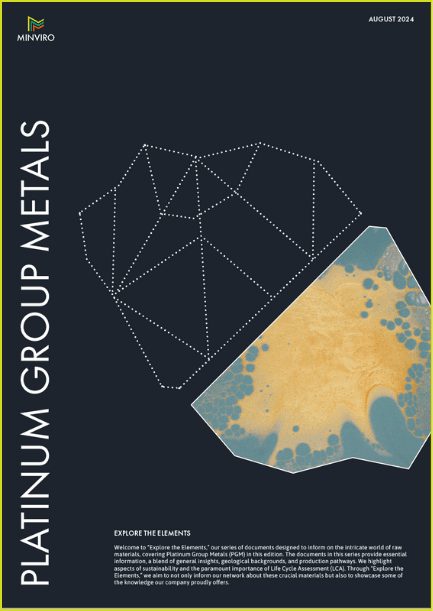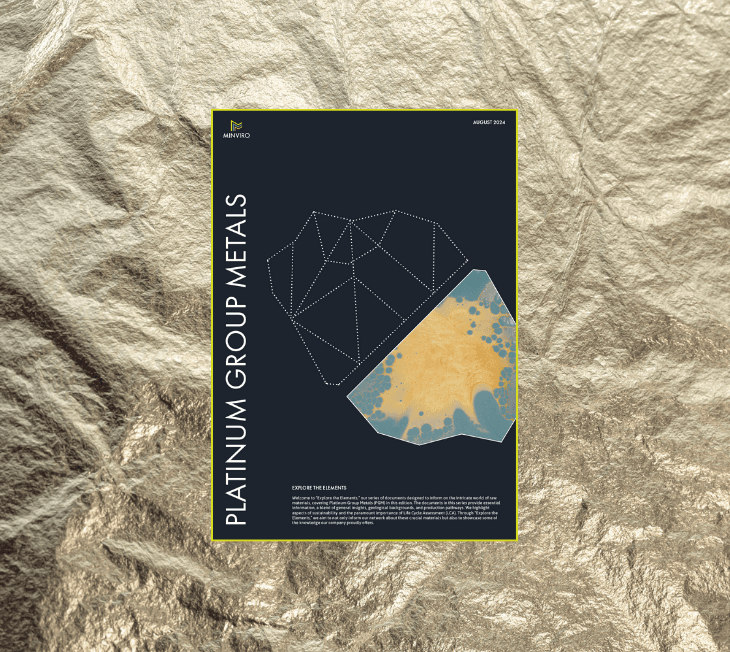- solutions
- industries
- about us
- resources
Client Resources
Explore the Elements: Platinum Group Metals
By Jordan Lindsay
In this edition of "Explore the Elements," we delve into the fascinating world of Platinum Group Metals (PGMs). This group of elements, including platinum, palladium, rhodium, iridium, osmium, and ruthenium, is known for its unique properties and critical applications across a range of industries. PGMs are essential to various high-tech and industrial processes, from automotive catalytic converters to hydrogen fuel cells.
Download
The outline
What Are Platinum Group Metals?
The Platinum Group Metals are a family of six transition metals that are highly valued for their exceptional chemical and physical properties. These metals are characterised by their high melting points, corrosion resistance, and excellent catalytic abilities. PGMs are not only rare but also incredibly versatile, playing a crucial role in everything from pollution control to electronics and jewellery.
This specific white paper is focused on Platinum Group Metals.
Platinum Group Metals in High-Tech Applications
The Platinum Group Metals (PGMs) are indispensable to numerous high-tech applications due to their unique chemical properties. From catalytic converters in vehicles to critical components in hydrogen fuel cells, PGMs play a vital role in advancing modern technology. As industries increasingly shift towards sustainable solutions, the demand for PGMs continues to rise, driven by their essential role in decarbonisation efforts and advanced manufacturing.
The Geology of PGM Deposits
PGMs are among the rarest elements in the Earth's crust, occurring in only a few, highly specialised geological settings. Major deposits are found in South Africa, Russia, and Canada, with each region presenting unique geological challenges and opportunities. The Bushveld Complex in South Africa, for example, is the world’s largest PGM deposit, renowned for its rich concentration of platinum and other metals. Understanding the geology of these deposits is crucial for the effective extraction and sustainable management of these valuable resources.
Pathways to Sustainable PGM Production
The production of PGMs involves complex and energy-intensive processes that span mining, concentration, smelting, and refining. This report explores the entire PGM supply chain, from the initial extraction of ore to the final refinement of metals. It highlights the industry's ongoing efforts to adopt more sustainable practices, such as reducing carbon emissions and improving energy efficiency, while ensuring that the high purity required for industrial applications is maintained.
Environmental Sustainability in PGM Extraction
The environmental impact of PGM extraction is significant, particularly in terms of water usage, land disturbance, and greenhouse gas emissions. This section of the report delves into the sustainability challenges faced by the PGM industry and the steps being taken to mitigate these impacts. Emphasis is placed on the importance of adopting environmentally friendly technologies and practices, such as the use of renewable energy sources and the recycling of PGM-containing products.
The Impact of LCA in the PGM Sector
Life Cycle Assessment (LCA) is an essential tool in understanding and reducing the environmental footprint of PGM production. By analysing the entire lifecycle of PGMs—from mining and processing to end-use and disposal—LCA helps identify opportunities for improving sustainability. This report examines the role of LCA in the PGM sector, providing insights into how companies can optimise their processes to minimise environmental impacts and contribute to a more sustainable future.
download
Get access today
Fill in the form below
Download
